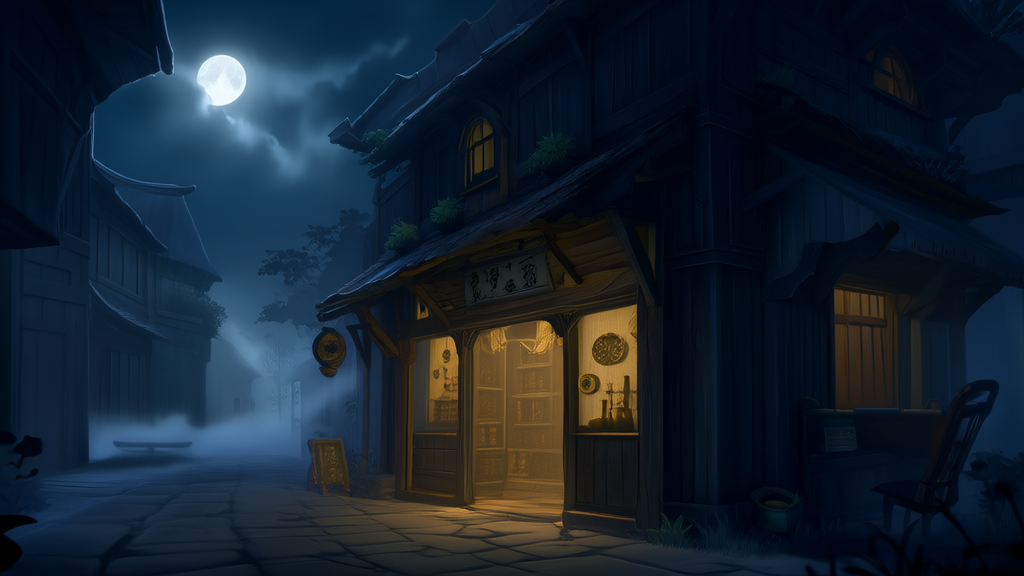🔮 Weird Tales & Urban Legends
The Secret of Eldridge's Curiosities: A Shop That Opens Only When the Moon Is Full

In a quiet village nestled between misty hills, there was an old antique shop that few dared to enter. The sign above the door read "Eldridge's Curiosities," and though the name was unfamiliar, the shop itself had a reputation that lingered like smoke from a long-extinguished fire. Its windows were always dark, and the only time it opened was when the moon was full. Most townspeople believed it was abandoned, but those who had ventured inside spoke of strange things—objects that seemed to shift when you weren’t looking, whispers in languages no one knew, and a lingering sense of being watched.
One evening, a young woman named Lila wandered into the shop, drawn by the faint glow of a single candle burning behind the dusty glass. She had heard stories about the shop from her grandmother, who warned her that some objects carried more than just history—they carried memories, or worse, something else entirely.
Inside, the air was thick with the scent of aged wood and mildew. Shelves lined the walls, each filled with trinkets that seemed out of place—clocks that ticked backward, mirrors that reflected nothing, and a small wooden box that hummed softly when touched. Lila reached for a silver locket on a velvet cushion, its surface etched with symbols she couldn’t recognize. As her fingers brushed the metal, a cold shiver ran down her spine, and the room seemed to darken slightly, as if the shadows themselves had moved closer.
The shopkeeper, a tall man with hollow eyes and a voice like rusted hinges, appeared from the back. He didn’t speak at first, only observed her with a knowing look. “You’ve chosen well,” he said finally, his voice low and deliberate. “That locket has been waiting for someone.”
Lila asked what it was, but the man only smiled. “It’s not what it is. It’s what it remembers.” He handed her a small note wrapped in yellowed paper. “If you ever wish to return, come when the moon is high. But be careful—some things are better left undisturbed.”
She took the locket and the note, feeling both intrigued and uneasy. That night, she opened the locket in her dimly lit room. Inside was a faded photograph of a woman with sorrowful eyes, and beneath it, a date that was decades older than the locket itself. When she closed it, the room grew colder, and the clock on her wall stopped ticking.
Over the next few days, Lila noticed strange changes. Her dreams were filled with visions of a woman walking through a rain-soaked street, calling her name. She would wake up with the feeling of being followed, though no one was there. The locket began to warm when she held it, and sometimes, when she looked into her mirror, she saw a figure standing behind her, only to turn and find nothing.
One night, she decided to follow the note’s instructions. She returned to the shop when the moon was high, the sky painted in deep indigo. The door creaked open as if expecting her. The shopkeeper was waiting, seated behind a desk piled with books and artifacts. “You’ve come back,” he said, not surprised. “Do you know why?”
“I don’t,” she admitted. “But I need to understand.”
He led her to a hidden room behind the counter, where the walls were covered in photographs and handwritten notes. Each object had a story, a life, and a curse. The locket, he explained, belonged to a woman who had died alone, her heart broken by betrayal. The locket had absorbed her grief, and now it sought someone to carry it forward.
“You’re not the first,” he said. “And you won’t be the last. But once you take it, you become part of its story.”
Lila felt the weight of the words. She had always thought of herself as ordinary, but now she wondered—was she simply another thread in a long, tangled tapestry? The locket pulsed in her hand, and she could feel the presence of the woman within it, watching, waiting.
As she stepped back into the night, the shopkeeper called after her, “Be careful what you choose to remember.”
She never returned to the shop again, but the locket remained with her. Sometimes, when she looked at it, she thought she could hear the woman whispering in her ear. And though she tried to forget, the truth lingered: some things are not meant to be owned. Some things are meant to haunt.
Published on en
🔗
Related Sites
- AI Blog — AI trends and tech news